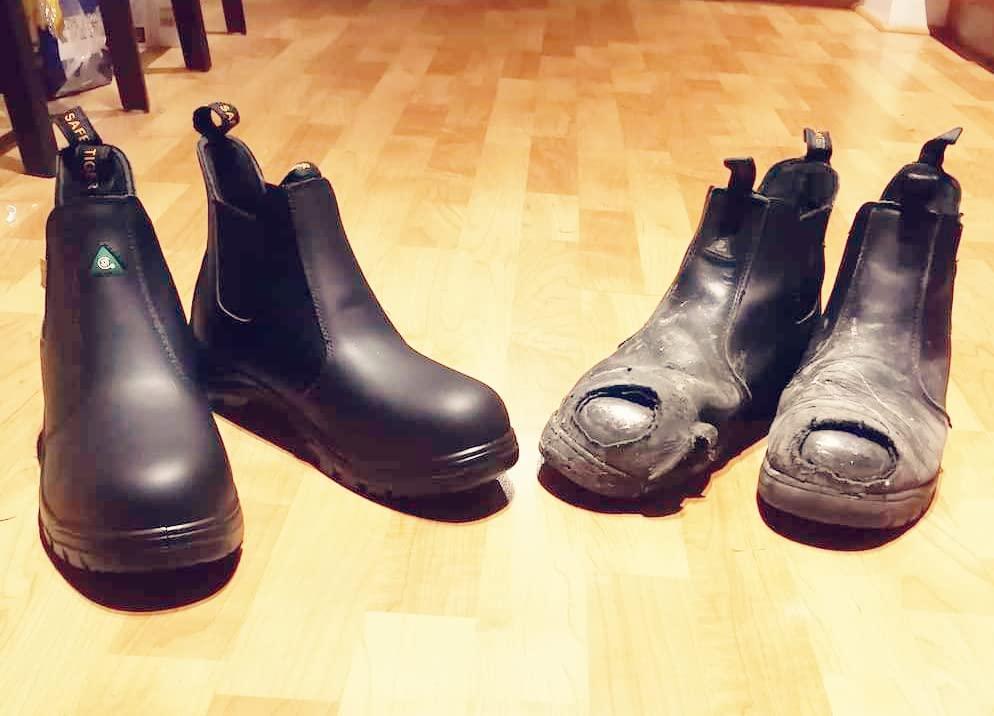Ensuring your employees have the right footwear for the job is essential to their safety, comfort, and productivity. Use this guide to assess the needs of your work environment and help choose the correct safety shoes for your workers.
Shop CSA Approved Men Work Safety Shoes
Shop CSA Approved Women Work Safety Shoes
Types of Safety Shoes for Different Work Environments
To comply with federal regulations enforced by the Occupational Safety & Health Administration (OSHA), protective footwear is required for workers in industrial settings and it is considered a form of PPE. Some safety shoes may be designed to protect against one hazard while others are designed to protect against multiple.

Safety Toe Shoes
Safety toe shoes feature a metal or nonmetal toe cap to protect toes against impact from falling objects.
- Some are also designed to protect against compression, punctures, and cuts
- Popular choice for warehouses, manufacturing facilities, and construction sites
Composite Toe Shoes
Composite toe work shoes are made from a combination of durable, non-metal materials such as Kevlar, carbon fiber, and plastic. When comparing composite toe vs steel toe shoes, composite toe boots are more lightweight and breathable, making them a more comfortable choice to wear for long periods of time. They are also less likely to be affected by fluctuating or extreme temperatures.
Pros:
- Lightweight and breathable
- Won't interfere with metal detectors in the workplace, making them ideal for security guards and law enforcement
- Poor conductor of electricity makes them an optimal choice for electrical hazard prone environments
- Great for use in extreme temperatures because they do not heat up or cool down like metal
Cons:
- Not as impact-resistant as metal toe shoes
- Typically more expensive
Steel Toe Work Shoes
Steel toe work shoes feature a steel capping over the toe area to provide protection against falling objects. One of the most popular and reliable choices for protective footwear, steel toe shoes are ideal for warehouses, manufacturing plants, and other industrial sites working with heavy machinery and objects.
Pros:
- Offers the maximum protection against impact compared to other safety-toed shoes
- Ideal for environments with heavy machinery
- Affordable option
Cons:
- Not ideal for environments with extreme temperatures
- Heavy construction may not be comfortable to wear for long periods of time
- Set off metal detectors
- Conducts electricity
Alloy Toe Work Shoes
Alloy toe shoes are made up of durable yet lightweight materials like aluminum and titanium. They are ideal for industrial work environments where comfort and moveability are just as important as impact resistance.
Pros:
- More lightweight than steel and composite toe boots (typically 30-50% lighter than steel)
- Thinner than steel for more toe room and overall more comfort
Cons:
- Sets off metal detectors
- Conducts electricity
- More expensive than steel boots
- Slightly less impact-resistant than steel toe shoes
Electrical Hazard Protection Shoes

Electrical hazard protection shoes feature electric-shock-resistant soles and heels that can withstand up to 18,000 volts or 60 Hertz for an entire minute with no current flow or leakage of more than a milliampere.
- Nonconductive and will prevent the wearers' feet from completing an electrical circuit to the ground
- Ideal for those who work with electricity, circuits, wiring, and high voltage machines
Moisture Protection Shoes

Moisture-resistant shoes are designed to keep feet dry in wet conditions and come in two types: waterproof and water-resistant. Waterproof shoes are best for conditions where you may be standing in areas with shallow water for an extended period of time. Water-resistant shoes are best for conditions where you may need protection from infrequent splashes of water.
- Help keep feet dry for optimal working conditions
- Protect against mold, rot, and fungus growth
Waterproof Work Shoes
Waterproof shoes have a special membrane coating that will cause water to bead up and roll off the shoe to keep water out and your feet completely dry.
Pros:
- Ideal for environments with harsh weather conditions and/or where water is frequently present
- Provides protection from moisture and cold air
- Made with durable materials for long-lasting use
Cons:
- Less breathable and more heavy-weight
- Typically more expensive
- Harder to clean
Water-Resistant Work Shoes
Water-resistant shoes will not bead and eventually the material will let water into the shoe.
Pros:
- Ideal for environments that may have mild, infrequent wet conditions
- Breathable and lightweight
- Easy to clean
Cons:
- Will eventually let water inside the shoe
- Not ideal for harsh weather environments
- Not as durable as waterproof shoes
Factors to Consider When Purchasing Work Shoes
When considering the type of safety shoes you need for the job, it is important to look at the hazards that may be present at your worksite.
If your workplace has any of the following hazards, then you will need to require protective footwear:
- Electrical hazards
- Hot substances and/or corrosive or poisonous chemicals
- Hot, wet, or slippery surfaces
- Heavy objects, such as barrels or drums, that could roll and/or fall onto feet
- Sharp objects, such as nails or glass, that could puncture the foot
- Molten metal that could splash onto feet or legs
- Static electricity that could cause an explosion
Here are some other questions to consider when looking for the correct safety shoe:
Will your employees be on their feet for long periods of time? A cushioned insole or midsole will help absorb shock to provide support and prevent foot pain and back aches.
Will your employees be working in cold conditions? Insulated work boots are a must if you work outside or are exposed to other cold conditions.
Footwear Safety Ratings Explained
To be considered protective footwear, a shoe must meet the guidelines set by the American Society for Testing and Materials (ASTM). The ASTM F2413, Standard Specification for Performance Requirements for Protective (Safety) Toe Cap Footwear, sets the minimum standards and testing procedures for safety footwear.
Safety footwear does not need to meet all the below requirements to conform to the ASTM F2413 standard. However, it should clearly state which of the requirements the footwear meets. Here are some protective footwear codes and what rating they stand for:
- M: male
- F: female
- I/75: impact protection rating
- C/75: compression protection rating
- Mt/75: metatarsal protection rating
- CD: conductive protection
- EH: electrical hazard resistance
- PR: puncture-resistant
- SD: static dissipative
- WR: water-resistant
How to Read an ASTM-Certified Product's Designation
Let's breakdown the following shoe safety rating by looking at its codes.
ASTM F2413-11
M I/75 C/75
EH
- The first line identifies that the shoe complies with the ASTM F2413 standard that was issued in 2011.
- In the second line, the M indicates that this is a men's shoe. The I/75 and C/75 ratings denote that the footwear meets Class 75 impact and compression resistance, which means the shoe will protect the user from an impact of up to 75 ft-lb. and compressive loads of 2,500 lb.
- The EH rating lets you know that this shoe provides electrical shock resistance protection.

